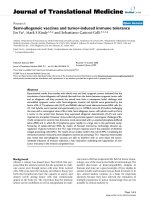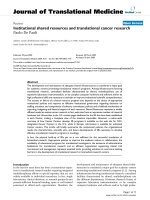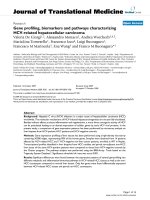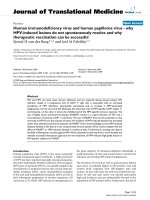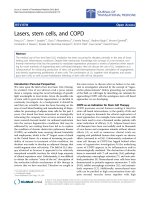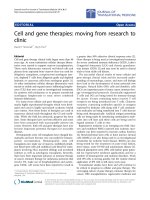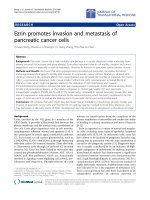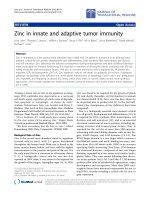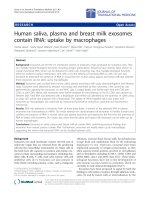báo cáo hóa học:" Two levels above and one level below pedicle screw fixation for the treatment of unstable thoracolumbar fracture with partial or intact neurology" pot
Bạn đang xem bản rút gọn của tài liệu. Xem và tải ngay bản đầy đủ của tài liệu tại đây (340.51 KB, 6 trang )
BioMed Central
Page 1 of 6
(page number not for citation purposes)
Journal of Orthopaedic Surgery and
Research
Open Access
Research article
Two levels above and one level below pedicle screw fixation for the
treatment of unstable thoracolumbar fracture with partial or intact
neurology
Hitesh N Modi
1
, Kook Jin Chung*
1
, Il Woo Seo
1
, Hoi Soo Yoon
2
,
Ji Hyo Hwang
1
, Hong Kyun Kim
1
, Kyu Cheol Noh
1
and Jung Han Yoo
1
Address:
1
Department of Orthopedics, Kangnam Sacred Heart Hospital, College of Medicine, Hallym University, Seoul, Korea and
2
Department
of Radiology, Hallym Sacred Heart University Hospital, College of Medicine, Hallym University, Seoul, Korea
Email: Hitesh N Modi - ; Kook Jin Chung* - ; Il Woo Seo - ;
Hoi Soo Yoon - ; Ji Hyo Hwang - ; Hong Kyun Kim - ;
Kyu Cheol Noh - ; Jung Han Yoo -
* Corresponding author
Abstract
Background: Treatment of unstable thoracolumbar fractures is controversial regarding short or
long segment pedicle screw fixation. Although long level fixation is better, it can decrease one
motion segment distally, thus increasing load to lower discs.
Methods: We retrospectively analyzed 31 unstable thoracolumbar fractures with partial or intact
neurology. All patients were operated with posterior approach using pedicle screws fixed two
levels above and one level below the fracture vertebra. No laminectomy, discectomy or
decompression procedure was done. Posterior fusion was achieved in all. Post operative and at final
follow-up radiological evaluation was done by measuring the correction and maintenance of
kyphotic angle at thoracolumbar junction. Complications were also reported including implant
failure.
Results: Average follow-up was 34 months. All patients had full recovery at final follow-up.
Average kyphosis was improved from 26.7° to 4.1° postoperatively and to 6.3° at final follow-up.
And mean pain scale was improved from 7.5 to 3.9 postoperatively and to 1.6 at final follow-up, All
patients resumed their activity within six months. Only 4 (12%) complications were noted including
only one hardware failure.
Conclusion: Two levels above and one level below pedicle screw fixation in unstable
thoracolumbar burst fracture is useful to prevent progressive kyphosis and preserves one motion
segment distally.
Background
The thoracolumbar junction is the most common site of
spinal injuries. The surgical treatment of unstable frac-
tures and fracture dislocations of thoracolumbar spine
remains controversial [1]. The goals of treatment in thora-
columbar fractures are restoring vertebral column stability
and obtaining spinal canal decompression, leading to
early mobilization of the patient. Either anterior, poste-
Published: 27 July 2009
Journal of Orthopaedic Surgery and Research 2009, 4:28 doi:10.1186/1749-799X-4-28
Received: 8 January 2009
Accepted: 27 July 2009
This article is available from: />© 2009 Modi et al; licensee BioMed Central Ltd.
This is an Open Access article distributed under the terms of the Creative Commons Attribution License ( />),
which permits unrestricted use, distribution, and reproduction in any medium, provided the original work is properly cited.
Journal of Orthopaedic Surgery and Research 2009, 4:28 />Page 2 of 6
(page number not for citation purposes)
rior or both approaches can be used to achieve fusion but
the efficacy of either approach is the same [2,3]. However,
posterior approach is less extensive, and most spine sur-
geons advocate posterior fusion as the treatment of choice
for unstable thoracolumbar injuries [4,5]. The importance
of early decompression and stabilization of unstable ver-
tebral injuries has been emphasized in several reports
[4,6]. Pedicle screw devices allow immediate stable fixa-
tion as the screws traverse all the three columns. Short-
segment (SS) pedicle instrumentation has become a pop-
ular method since Dick et al [7] introduced the "fixateur
interne" device. Various techniques have since arisen for
the management of unstable thoracolumbar fractures.
Nowadays, controversy still exists over whether SS pedicle
instrumentation is a suitable method. Biomechanical and
clinical studies, however, have shown that when there is
loss of more than 50% of the vertebral body height or
angulations of the thoracolumbar junction of more than
20° [8], acute spinal instability results, and the spinal seg-
ment will eventually fail with weight-bearing. Biome-
chanical studies have also shown that spinal instability
results when there is a failure of at least two of Denis three
columns [9]. Gurr et al [10] found that CD instrumenta-
tion placed two levels above and two levels below the
injured level in an unstable calf spine model provided
more stiffness than that in the intact spine. Krag [11] has
suggested segmental pedicle fixation two levels above the
kyphosis to prevent implant failure. Carl et al [4] reported
that segmental transpedicular fixation two levels above
the kyphosis should be used at the thoracolumbar junc-
tion where compressive forces act more anteriorly,
whereas in the more lordotic middle and lower lumbar
spine where the compressive forces act more posteriorly,
no implant failure occurred with use of the one above-one
below construct.
Here we present our results in unstable thoracolumbar
fracture patients who were treated with pedicle screw fixa-
tion two level above and one level below the fracture ver-
tebra, in order to preserve motion segment below the level
of fracture. The purpose was to study the effectiveness of
pedicle screw fixation, two levels above and one level
below the fractured vertebra, in order to prevent postoper-
ative kyphosis and high implant failure rate.
Methods
We retrospectively reviewed the results of unstable thora-
columbar fractures with partial or intact neurology in con-
secutive 31 patients who were operated between June
2004 and June 2006 at our institute by a single spine sur-
geon (Table 1). There were 18 males and 13 females with
an average age of 40.6 ± 12.7 (range, 19~63 years). There
were 7, 13 and 11 patients who had fractures at T11, T12
and L1 level, respectively. 22 patients had injury due
motor vehicle accident (MVA) and 9 had injury due to fall
from height. Neurologic compromise was graded accord-
ing to Frankel. There were 4, 7 and 20 patients with Fran-
kel grade C, D and E respectively. A postoperative
neurologic examination was also performed in all patients
1 year later and the findings compared with the preopera-
tive examination. Following a routine examination and X-
ray of the spine, computed tomography (CT) scan of the
involved vertebra and adjacent vertebrae was carried out.
McAfee's [12] system was used to classify the fractures.
There were 14 unstable burst (UB) fractures, 9 transla-
tional (TRS) injuries and 8 flexion-distraction (FD) inju-
ries. Frankel's grade system was used for assessment of
neurological deficit on admission and subsequently in the
follow-up.
Indication for surgical stabilization in patients who had
partial or intact neurology was based on instability criteria
of kyphotic deformity of more than 20° and/or vertebral
body height loss of more than 50 compared to vertebra
below. The senior author (KJC) performed all surgeries. At
surgery, the patients were placed in a hyperextended
prone position with the abdomen hanging free, thus pre-
venting excessive intraoperative bleeding and achieving a
significant initial reduction of the spinal fracture. All
patients were operated with single stage posterior surgery
using pedicle screw instrumentation, two levels above and
one level below the fractured vertebra (Figs. 1 and 2). All
pedicle screws were inserted under C-arm guidance. The
rod was then fixed two levels above the fracture into the
four screws and after that, torque was applied through the
rod pusher to bring the vertebra back to the rod. Gentle
distraction at the level of the fracture followed, restoring
tension to the posterior longitudinal ligament (ligamen-
totaxis) and thereby, achieving anatomic reduction. None
of our patients underwent discectomy and/or laminec-
tomy and decompression procedure. All the patients had
cross link fixation across the fracture site for preventing
windshiled effect of construct with at least one pedicle
screw fixation in the fractured vertebra. After the fixation,
posterior fusion achieved using cancellous bone grafts
harvested from posterior iliac crest.
All patients were managed with immobilization in a cus-
tom-molded thoracolumbosacral brace for three months
postoperatively. All patients with age more than 40 years
were investigated in form of DEXA (Dual Emission X-ray
Absorptiometry) to evaluate BMD (bone mineral density)
as a routine protocol in our clinic for the treatment of
osteoporosis. The patients were followed with serial phys-
ical examinations and radiographs. With the use of lateral
radiographs centered over the fracture level, kyphosis or
lordosis was measured from the superior end-plate of the
intact vertebra cephalad to the fracture to the inferior end-
plate of the vertebra caudad to the fracture. Progression
was considered to be absent, minor, or major. Minor pro-
Journal of Orthopaedic Surgery and Research 2009, 4:28 />Page 3 of 6
(page number not for citation purposes)
gression was defined as kyphosis measuring 5 to 10°
more at the time of follow-up than it had on the immedi-
ate postoperative radiographs. Major progression was
defined as an increase of 10° or more compared with the
measurement on the initial postoperative radiographs.
Denis pain score were also compared statistically for each
patient, immediate postoperatively and at the final fol-
low-up, with preoperative pain score.
Results
Average follow-up was 34 ± 8.2 months (range, 24~49
months). Mean injury surgical interval was 3.5 days rang-
ing from minimum 6 hours to maximum 14 days. Table 1
presents a master chart on the patients and their treat-
ment, including patient parameters, mode of trauma,
level of injury, type of fracture, injury surgery interval,
kyphotic angles (pre-operative, post-operative, loss of
kyphosis), neurological status, complications and pain
evaluations.
The average pre-operative kyphotic angle was 26.7° which
improved to 4.1° in the immediate post-operative period
suggesting 84.6% correction (p < 0.0001, paired t-test)
(Fig 1). At final follow-up it was 6.3° suggesting 76.4%
correction (p < 0.0001, paired t-test) (Fig 2). Considering
the change according to degree of progression, all but one
patients showed no progression of kyphosis more than 5-
degree at final follow-up. Only one patient (patient 18)
showed minor progression (6.1°) at the final follow-up.
The average pre-operative vertebral height was 41.9%
compared to the vertebra below the fracture, which
improved to 76.2% in the immediate postoperative
period. The loss of body height averaged 2.7% at the final
follow-up, and the loss of kyphotic correction averaged
2.2°. Similarly, the average preoperative pain scale
(Denis) was 7.5, which was improved to 3.9 (49.1%)
immediate postoperatively. At final follow-up mean pain
scale was 1.6 suggesting overall improvement of 79.1%
than preoperative level. Our findings also suggested con-
Table 1: Demographics of each patient with preoperative and postoperative kyphotic angle, neurological status and pain scale.
No Sex F-U
(months)
Age
(years)
Level Injury
(cause)
McAfee
(type)
ISI
(Days)
Kyphosis angle Neurology
(Frankel)
Pain Scale (Dennis)
Preop IMPO Final Preop Final Preop IMPO Final
1 M 44 19 L1 MVA FD 2 24 0 2 E E 7 3 1
2 M 43 44 T11 MVA UB 0 30 2.9 5.8 E E 8 4 2
3 F 42 28 T12 MVA UB 0 24.1 2 5.2 C E 7 4 1
4 M 42 60 L1 MVA UB 1 25.3 2 4.5 E E 9 5 2
5 F 36 43 T12 MVA UB 6 27.4 2.4 5.1 D E 7 4 1
6 F 30 54 T12 MVA UB 1 28.9 4.3 6.4 E E 9 5 2
7 M 28 42 T12 MVA UB 1 25.2 3 5.8 E E 8 5 2
8 F 27 24 T11 MVA UB 3 30.1 4.5 7.1 D E 9 4 3
9 M 49 28 T12 MVA UB 1 29.5 3.4 5.7 E E 7 4 1
10 M 24 39 T12 Fall TRS 1 29.3 4.2 5.8 D E 7 5 1
11 M 48 63 L1 Fall UB 1 29.3 5.3 7.7 E E 8 4 2
12 F 47 50 L1 MVA FD 5 29 5 6.5 C E 8 5 2
13 M 44 39 T12 Fall TRS 1 31.5 3.5 6.1 E E 9 6 2
14 M 29 42 L1 MVA UB 0 25.4 4.2 6.9 D E 6 5 2
15 M 28 39 T12 MVA UB 0 27.5 3.3 5.6 E E 7 3 1
16 M 26 40 L1 Fall TRS 10 26 10.5 16.4 E E 6 3 1
17 F 26 59 T12 MVA TRS 7 20.6 5.4 8.1 C E 6 4 2
18 F 46 33 T11 MVA TRS 4 20.5 7.3 8.6 E E 7 2 1
19 F 42 26 T12 Fall TRS 6 24 6 7.4 E E 7 2 1
20 M 24 24 T11 MVA FD 3 23 5 6.8 E E 7 3 2
21 M 34 48 L1 MVA FD 1 20.3 3.5 5.9 D E 6 3 1
22 M 33 30 T12 Fall FD 5 32.3 5.7 7.6 E E 9 4 3
23 F 33 55 T12 MVA TRS 4 31.5 2.5 3.8 E E 8 3 1
24 M 32 62 L1 MVA FD 1 24 4.3 5.8 E E 7 4 1
25 F 32 23 L1 Fall FD 8 21.8 4 5.8 D E 7 3 2
26 F 36 43 T11 MVA UB 6 22.8 3 5.2 E E 7 3 2
27 M 24 23 T11 Fall UB 3 20.5 4.6 6.5 E E 7 3 1
28 M 24 56 T11 Fall TRS 4 24.3 0 3.4 E E 7 4 1
29 F 27 42 L1 MVA TRS 7 35 8.4 9.8 D E 9 4 2
30 F 26 37 L1 MVA UB 3 30.3 3.7 4.6 E E 9 5 2
31 M 29 42 T12 MVA FD 14 35 3.2 5.9 C E 8 5 3
Abbreviations: F-U: Follow-Up; ISI: Injury Surgery Interval; IMPO: immediate post operative; MVA: motor vehicle accident; UB: Unstable burst
fracture; TRS: translational injury; FD: flexion-distraction injury; HWF: hard ware failure; SWI: superficial wound infection.
Journal of Orthopaedic Surgery and Research 2009, 4:28 />Page 4 of 6
(page number not for citation purposes)
tinuous improvement in pain scale after the surgery. All
the patients had Frankel grade E neurology at final follow-
up suggesting all the patients were improved in neurolog-
ical status after the surgery.
There were only four complications (12%). Two patients
(patient 12 and 19) had screw loosening. One was 63-
years-old male and other was 59-years-old female. They
were osteoporotic patients which were confirmed with
bone densitometry. Therefore screw loosening in them
was thought to be due to osteoporosis. None of them had
any deterioration in their functional activity. One 40 years
male (patient 18) had breakage of right L1 screw; however
there was no movement noted on flexion-extension radi-
ogram and patient was symptomless. No treatment was
done for the hardware failure in that patient. Finally, one
42-years-old male (patient 35) developed superficial
wound infection which was treated with repeated dress-
ings and parenteral antibiotics. His further follow-up was
uneventful. All patients were able to return to their previ-
ous activity within six months of surgery and none of the
patient had deterioration in neurology on regular follow-
up. At final follow-up there was no instability detected on
the flexion-extesion radiogram in all patients.
Discussion
Posterior transpedicular screw fixation initially was
reported by Boucher in 1959 [13]. Since then, modern
instrumentation systems have been developed. These sys-
tems control segmental motions in three dimensions, pre-
serve motion segments, avoid long fusions, and provide a
more stable construct [5]. As with all surgical implants;
transpedicular screw instrumentation maintains reduc-
tion until bony union is achieved. Short-segment poste-
rior fixation (SSPF) is the most common and simple
treatment, offering the advantage of incorporating fewer
motion segments in the fusion [14-17]. A review of the lit-
erature showed that SSPF alone led to a 9–54% incidence
of implant failure and re-kyphosis in the long-term fol-
low-up, and 50% of the patients with implant failure had
moderate-to-severe pain [18,15,19]. To prevent this, sev-
eral techniques have been developed to augment the ante-
rior column in burst fractures, such as transpedicular bone
grafting [18,20,15], placement of body augmenter [16],
polymethylmethacrylate (PMMA) injection [21], anterior
instrumentation and strut grafting [3], or long-segment
posterior fixation (LSPF) [14,22]. In current study we ret-
rospectively analyzed all patients who were treated with
posterior approach using pedicle screw fixation two levels
above and one level below the fracture vertebra, to study
the effectiveness of fixation in preventing postoperative
development of kyphosis and hardware failure.
Although SS pedicle instrumentation has been considered
as a superior method, [7,23] several studies showed that
SS pedicle instrumentation had a high rate of failure
[18,19]. Nevertheless, some studies demonstrated that
clinical long-term results were favorable in patients who
underwent SS pedicle instrumentation [23]. McLain et al
[19], in their report of early failure of SSPF for thoraco-
lumbar burst fracture noted three kinds of hardware fail-
ure with this fixation: progressive kyphosis secondary to
the bending of screws, kyphosis secondary to osseous col-
lapse or vertebral translation without bending of the hard-
ware, and segmental kyphosis after a caudad screw in the
lumbar construct broke. And they noted that untreated
anterior instability, and pre-stressing of the screws when
the rods were contoured in situ, resulted in a high rate of
failure. Altay et al [24] reported that use of four pairs of
screws (two above and two below) to lengthen the level
arm of the construct would probably not only enhance
the stability but also allow effective reduction of kyphotic
deformity. SSPF alone can give good clinical and radiolog-
ical outcomes for certain fractures in the thoracolumbar
junction. Detection of such fractures in which SSPF, with-
out supporting anterior column, is sufficient and does not
lead to implant failure and correction loss. Tezeren and
showing preoperative a) AP and b) lateral radiogram of a patient with unstable L1 fracture with kyphosis of 28-degreesFigure 1
showing preoperative a) AP and b) lateral radiogram
of a patient with unstable L1 fracture with kyphosis
of 28-degrees. Immediate postoperative c) AP and d) lateral
radiogram showed correction of kyphosis.
Journal of Orthopaedic Surgery and Research 2009, 4:28 />Page 5 of 6
(page number not for citation purposes)
Kuru [25], in their study comparing short segment versus
long segment fixation in thoracolumbar burst fractures,
demonstrated that LS instrumentation is an effective way
to manage thoracolumbar burst fractures. SS pedicle
instrumentation had a high rate of failure. However, LS
instrumentation prolonged the operative time and
increased the amount of blood loss significantly. De Per-
etti et al [20] suggested that fixation by screw and hook
constructs, gripping the two vertebrae above the lesion
and screws and hooks gripping the first vertebra below the
lesion, was an effective way to stabilize thoracolumbar
junction burst fractures. Carl et al [4] also reported that
segmental transpedicular fixation two levels above the
kyphosis should be used at the thoracolumbar junction
where compressive forces act more anteriorly. Therefore
we prefer to put the pedicle screw two levels above the
fracture site in order to prevent progressive kyphosis as
well as hard ware failure. On the other hand preferring
one level fixation distal to fracture site was to preserve the
motion segment as much as possible in the lumbar level.
Our result showed that we have achieved both our pur-
poses with this fixation.
As all of the patients in our study had partial or intact neu-
rology at the time of presentation, decision to operate was
taken if they had kyphosis angle more than 20-degree
and/or anterior vertebral body height more than 50%;
which suggested unstable fractures. Average preoperative
kyphosis angle was 26.7° preoperatively which improved
to 4.1° immediate postoperatively and maintained at
6.3° at final follow-up. Our results suggested a success
similar to LSPF construct reported in the literature. And
we agree that fixing the fracture two levels above prevents
progressive kyphosis development. Additionally evalua-
tion of pain scale for all the patients suggested that our fix-
ation strategy had been successful in improving the pain
scales at final follow-up and all the patients were able to
go back to their previous level of activity after the opera-
tion.
Butt et al [26] recently reported success of short segment
pedicle screw fixation in thoracolumbar burst fractures;
however the 40% (20 out of 50 patients) hardware failure
rate that they reported is worrisome. We think that this
high rate of implant failure is probably due to SSPF. In the
present study we had only 12% (four patients out of 31)
complication rate; one superficial wound infection, two
screw loosening and one screw breakage. Screw loosening
was found in patients with elder age which was probably
due to their poor bone quality and therefore only one
patient (42-years-old male) developed implant failure
which is quite low than SSPF in the literature. We think
that two level above and one level below pedicle screw fix-
ation has high success rate in preventing hardware failure
related complication similar to LSPF; and additionally we
could save one motion segment distally as well in all the
patients.
As our patients had partial neurological injury or intact
neurology, we could preserve the lamina and other poste-
rior structures in all patients. We feel that further study
comparing the effectiveness of this construct in patients
with laminectomy would be helpful to confirm the suc-
cess of this technique. We think this could be the only
weak factor in our study and we recommend further study
in laminectomized patients in future. Additionally, we
could not evaluate the union in all patients because all
subjects did not undergo for CT scan at final follow-up.
However, there was no instability noted on flexion-exten-
sion radiogram at final follow-up.
Conclusion
Our study reported prevention of progressive kyphosis
development with the use of two levels above and one
level below pedicel screw construct in unstable thoraco-
lumbar burst fractures in patients with partial or intact
neurology. Additionally it is helpful to preserve one
at final follow-up (3 years) a) AP and b) lateral radiogram showed maintenance of correction in kyphosis, and c) flexion and d) extension view showed good lumbar motion with maintenance of correctionFigure 2
at final follow-up (3 years) a) AP and b) lateral radio-
gram showed maintenance of correction in kyphosis,
and c) flexion and d) extension view showed good
lumbar motion with maintenance of correction.
Publish with BioMed Central and every
scientist can read your work free of charge
"BioMed Central will be the most significant development for
disseminating the results of biomedical research in our lifetime."
Sir Paul Nurse, Cancer Research UK
Your research papers will be:
available free of charge to the entire biomedical community
peer reviewed and published immediately upon acceptance
cited in PubMed and archived on PubMed Central
yours — you keep the copyright
Submit your manuscript here:
/>BioMedcentral
Journal of Orthopaedic Surgery and Research 2009, 4:28 />Page 6 of 6
(page number not for citation purposes)
motion segment distally at lumbar level and improving
the pain scale at final follow-up.
Competing interests
The authors declare that they have no competing interests.
Each author certifies that he has no commercial associa-
tions (e.g. consultancies, stock ownership, equity inter-
ests, patent/licensing arrangements, etc) that might pose a
conflict of interest in connection with the submitted arti-
cle.
Authors' contributions
HNM has contributed in conception and design of data,
analysis and interpretation of data, drafting the manu-
script and revising it critically, KJC has contributed in con-
ception and design of data, drafting the manuscript and
given the final approval of manuscript, IWS has contrib-
uted in drafting the manuscript and data analysis, HSY has
contributed acquisition of data and revising it critically,
JHH has contributed in acquisition of data, revising the
manuscript critically and given the final approval, HKK
has contributed in drafting the manuscript and designing
of data and revising it critically, KCN has contributed in
acquisition of data and analysis and interpretation of
data, and JHY has contributed in acquisition and analysis
of data. All authors read and approved the final manu-
script.
References
1. Yue JJ, Sossan A, Selgrath C, Deutsch LS, Wilkens K, Testaiuti M,
Gabriel JP: The treatment of unstable thoracic spine fractures
with transpedicular screw instrumentation: a 3-year consec-
utive series. Spine 2002, 27(24):2782-2787.
2. Danisa OA, Shaffrey CI, Jane JA, Whitehill R, Wang GJ, Szabo TA,
Hansen CA, Shaffrey ME, Chan DP: Surgical approaches for the
correction of unstable thoracolumbar burst fractures: a ret-
rospective analysis of treatment outcomes. J Neurosurg 1995,
83:977-83.
3. Kaneda K, Taneichi H, Abumi K, Hashimoto T, Satoh S, Fujiya M:
Anterior decompression and stabilization with the Kaneda
device for thoracolumbar burst fractures associated with
neurological deficits. J Bone Joint Surg Am 1997, 79:69-83.
4. Carl AL, Tromanhauser SG, Roger DL: Pedicle screw instrumen-
tation for thoracolumbar burst fractures and fracture-dislo-
cation. Spine 1992, 17:S317-324.
5. Roy-Camille R, Saillant G, Mazel C: Internal fixation of the lum-
bar spine with pedicle screw plating. Clin Orthop 1986, 203:7-17.
6. Korovessis P, Baikousis A, Stamatakis M: Use of the Texas Scot-
tish Rite Hospital Instrumentation in the treatment of tho-
racolumbar injuries. Spine 1997, 22:882-888.
7. Dick W, Kluger P, Magerl F, Woersdorfer O, Zach G: A new device
for internal fixation of thoracolumbar and lumbar spine frac-
tures: the fixateur interne. Paraplegia 1985, 23:225-232.
8. Nagel DA, Koogle TA, Piziali RL, Perkash I: Stability of upper lum-
bar spine following progressive disruption and the applica-
tion of individual internal and external devices. J Bone Joint
Surg Am 1981, 63:62-70.
9. Haher TR, Bergman M, O'Brien M, Felmly WT, Choueka J, Welin D,
Chow G, Vassiliou A: The effect of three column of spine on the
instantaneous axis of rotation in flexion and extension. Spine
1991, 16:S312-318.
10. Gurr KR, McAfee PC, Shih CM: Biomechanical analysis of ante-
rior and posterior instrumentation systems after corpec-
tomy: A calf-spine model.
J Bone Joint Surg Am 1988, 70:1182-91.
11. Krag MH: Biomechanics of thoracolumbar spinal fixation: A
review. Spine 1991, 16:S84-99.
12. McAfee PC, Yuan HA, Fredrickson BE, Lubicky JP: The value of
computed tomography in thoracolumbar fractures. An anal-
ysis of one hundred consecutive cases and a new classifica-
tion. J Bone Joint Surg Am 1983, 65:461-473.
13. Boucher HH: A method of spinal fusion. J Bone Joint Surg Br 1959,
41:248-259.
14. Akbarnia BA, Crandall DG, Burkus K, Matthews T: Use of long rods
and a short arthrodesis for burst fractures of the thoraco-
lumbar spine. A long-term follow-up study. J Bone Joint Surg Am
1994, 76(11):1629-1635.
15. Knop C, Bastian L, Lange U, Oeser M, Zdichavsky M, Blauth M: Com-
plications in surgical treatment of thoracolumbar injuries.
Eur Spine J 2002, 11(3):214-226.
16. Li KC, Hsieh CH, Lee CY, Chen TH: Transpedicle body aug-
menter: a further step in treating burst fractures. Clin Orthop
Relat Res 2005, 436:119-125.
17. Parker JW, Lane JR, Karaikovic EE, Gaines RW: Successful short-
segment instrumentation and fusion for thoracolumbar
spine fractures: a consecutive 4 1/2-year series. Spine 2000,
25(9):1157-1170.
18. Alanay A, Acarolu E, Yazici M, Oznur A, Surat A: Short-segment
pedicle instrumentation of thoracolumbar burst fractures:
does transpedicular intracorporeal grafting prevent early
failure. Spine 2001, 26(2):213-217.
19. McLain RF, Sparling E, Benson DR: Early failure of short-segment
pedicle instrumentation of thoracolumbar fractures. A pre-
liminary report. J Bone Joint Surg Am 1993, 75(2):162-167.
20. De Peretti F, Hovorka I, Cambas PM, Nasr JM, Argenson C: Short
device fixation and early mobilization for burst fractures of
the thoracolumbar junction. Eur Spine J 1996, 5:112-120.
21. Cho DY, Lee WY, Sheu PC:
Treatment of thoracolumbar burst
fractures with polymethyl methacrylate vertebroplasty and
short-segment pedicle screw fixation. Neurosurgery 2003,
53(6):1354-1360.
22. Gurr KR, McAfee PC: Cotrel-Dubousset instrumentation in
adults. A preliminary report. Spine 1988, 13:510-520.
23. Rommens PM, Weyns F, Van Calenbergh F, Goffin J, Broos PL:
Mechanical performance of the Dick internal fixator. A clin-
ical study of 75 patients. Eur Spine J 1995, 4:104-109.
24. Altay M, Ozkurt B, Aktekin CN, Ozturk AM, Dogan O, Tabak AY:
Treatment of unstable thoracolumbar junction burst frac-
tures with short- or long- segment posterior fixation in
magrel type a fractures. Eur Spine J 2007, 16:1145-1155.
25. Tezeren G, Kuru I: Posterior fixation of thoracolumbar burst
fracture. Short-segment pedicle fixation versus long-seg-
ment instrumentation. J Spinal Disord Tech 2005, 18:485-488.
26. Butt MF, Farooq M, Mir B, Dhar AS, Hussain A, Mumtaz M: Manage-
ment of unstable thoracolumbar spinal injuries by short seg-
ment pinal fixation. International Orthop 2007, 31:259-264.
